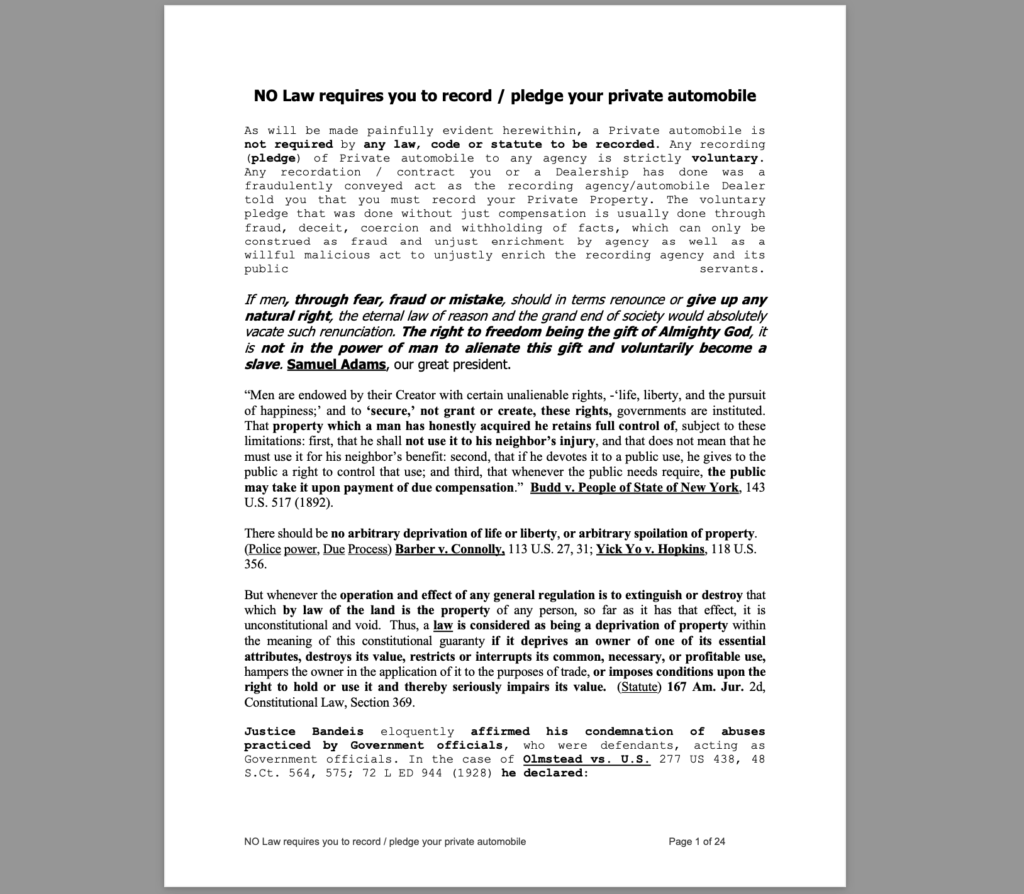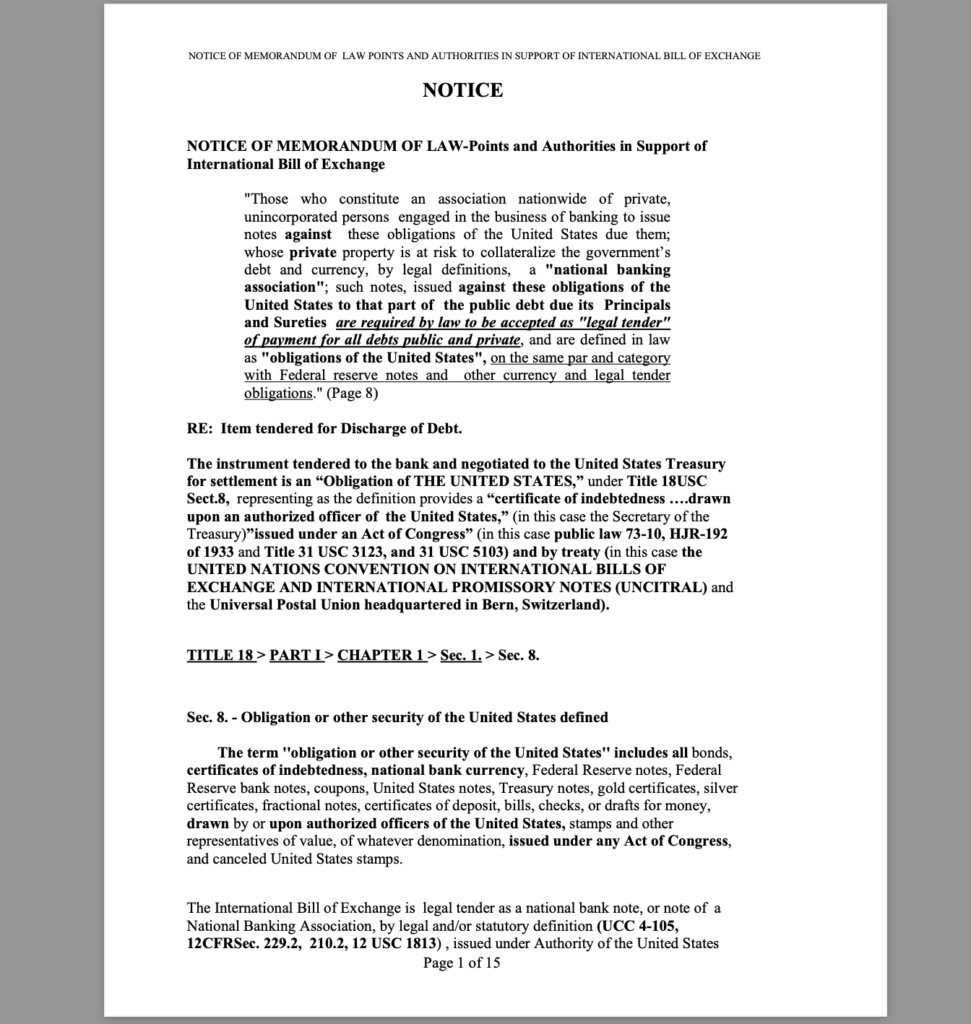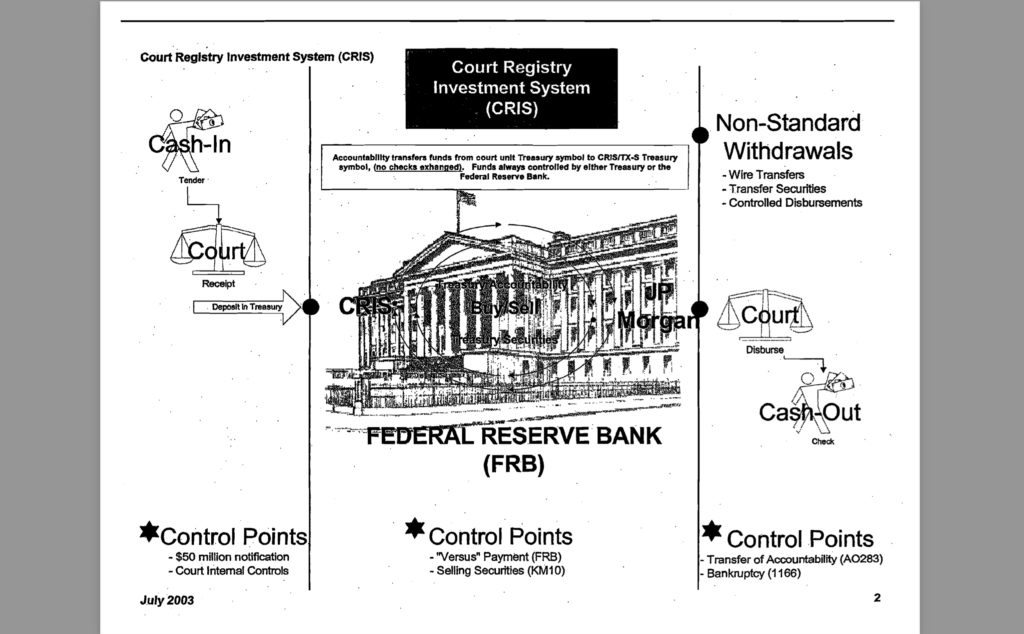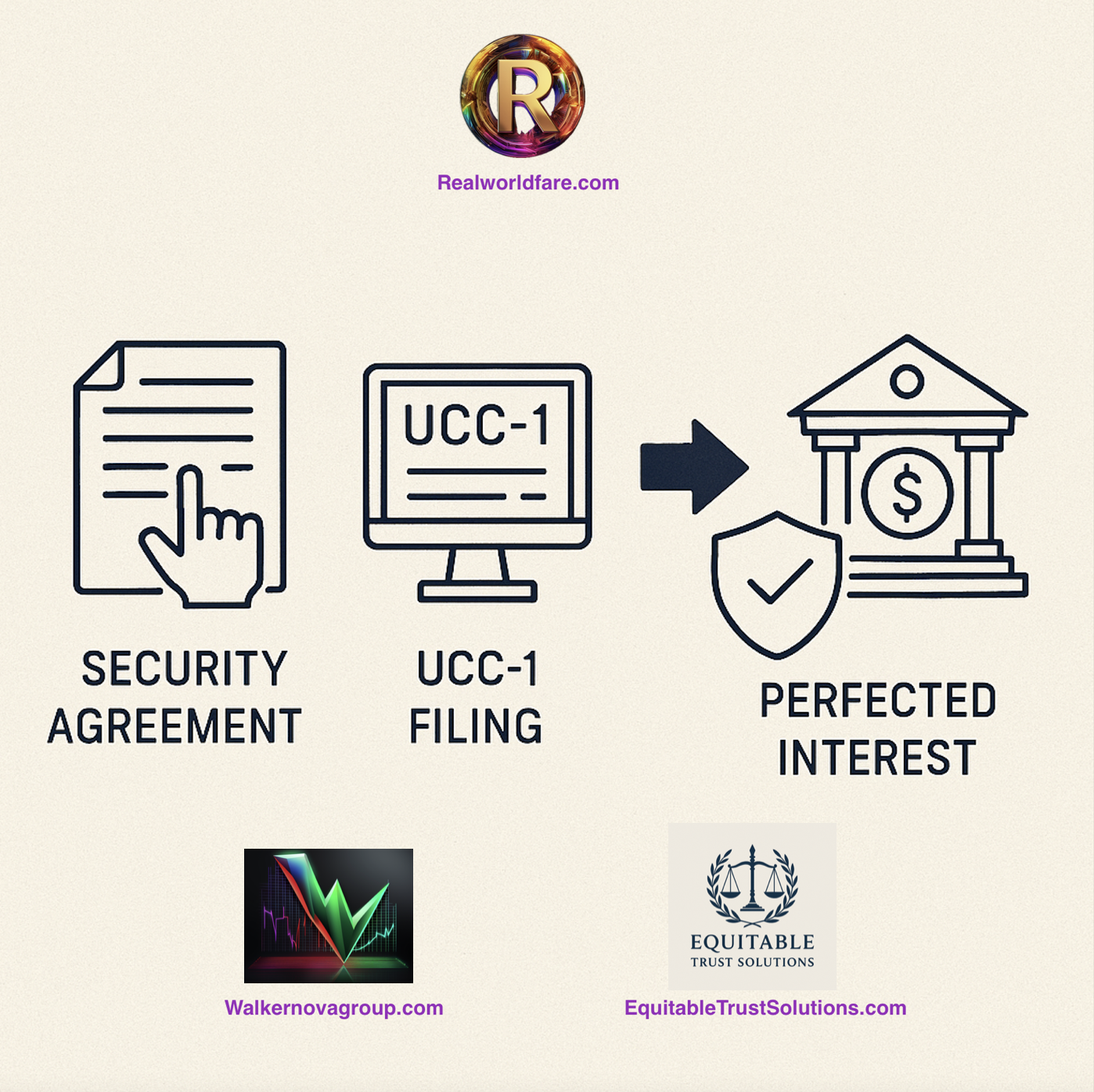REALWORLDFARE
Realworldfare is an inclusive private community rooted in equity, education, and conscious empowerment. We are committed to demystifying the legal and commercial frameworks that silently govern everyday life—bringing clarity to the often-hidden distinctions between rights, privileges, and obligations. Through fair and uncensored information, we support truth-seekers in reclaiming their private power.
Our platform offers educational resources and networking opportunities focused on Common Law, Constitutional Law, Equity, Public and Private Law, Trust and Contract Law, UCC Filings, Private Banking, Debt Instruments, Foreclosure Defense, Estate Planning, and lawful dealings involving Negotiable Instruments, Deeds, Bonds, and Commercial Equity.
We uphold that equity corrects what law cannot, and that the restoration of private remedy begins with comprehension. In a world increasingly dominated by the color of law, coercion, and administrative overreach, Realworldfare serves as a sovereign resource for those who choose to operate in truth, honor, and informed peace
Commonly misinterpreted and/or terms: individual, bank, financial institution, person, state Citizen, national, U.S. citizen, secured party, trust, attorney in fact, attorney at law, lawyer, minor, infant, discharge, pay, payment.
SEARCH WEBSITE
LATEST NEWS
How a Perfected Security Agreement and UCC Filings Strip Servicers of Foreclosure Rights
A properly executed Security Agreement assigning all assets, rights, and interests to a private trust—paired with a UCC-1 financing statement and UCC-3 amendment claiming the Deed of Trust and Note—lawfully establishes the trust as the secured party and real party in interest. This perfected interest, under UCC §§ 9-203, 9-509, 3-301, and supported by controlling case law (e.g., Carpenter v. Longan, Ibanez, Veal), strips any servicer or third-party of standing to foreclose unless they possess the original Note, prove an unbroken chain of title, and rebut the trust’s perfected claim. Without that, all foreclosure attempts become void ab initio, commercial dishonor, and legal trespass on private trust property.
Read MoreRiverside, California FEDERAL Judges Kenly Kato and Sunshine Sykes helping Tamara Wagner continue irreparable harm, engage In Blatant Misconduct, and Defy US Code, MANDATORY DISQUALIFICATION, AND DUE PROCESS
THE JUDICIARY IS ON TRIAL: Ultra Vires Actions, Mandatory Disqualification, and the Collapse of Due Process in the Central District […]
Read MoreCalifornia Courts Are a Rigged Machine of Corruption: Weaponized System That Protects Fraud and Destroys Remedy
This article exposes the deliberate design behind California’s judicial corruption, focusing on how courts enable foreclosure fraud and obstruct lawful remedy to protect financial interests. It outlines the deep ties between judges, public pensions, and mortgage-backed securities, explaining how systemic bias against pro se litigants and equity claims maintains a rigged foreclosure racket. From fraudulent trustees’ deeds to administrative sabotage, California courts serve revenue and institutional protection—not justice. The piece makes clear that equity, truth, and due process are casualties of a machine built to seize assets, not resolve claims.
Read MoreFEATURED SERVICES & PRODUCTS
-

Discharging Debt Through Equity Remedy: Vehicle, Mortgage, and Credit Relief
$10,000.00Original price was: $10,000.00.$6,000.00Current price is: $6,000.00. Add to cart -

Eliminate PURPORTED “Loan” on private Automobile, Recoup Assets, Payments, and ALL Money Paid
$6,000.00 Buy product -

AFFIDAVIT CERTIFICATE of NON-RESPONSE, DISHONOR, JUDGEMENT, and LIEN Authorization
$333.00Original price was: $333.00.$99.00Current price is: $99.00. Add to cart -

Mastering Administrative Process, the UCC, & Private Commercial Affairs
$3,333.00Original price was: $3,333.00.$1,333.00Current price is: $1,333.00. Add to cart -

RealworldfareGBT – Constitutional Law, Private Law, and Equity Strategist
$99.00 Add to cart -

Virtual Class: Introduction to Private Law, Contracts, and Estate Rights
$1,000.00Original price was: $1,000.00.$333.00Current price is: $333.00. ENROLL IN CLASS -

Private Consultations (Phone, Video, Private 1 on 1)
$333.00 SCHEDULE CONSULTATION -

™SOVEREIGN BLUEPRINT© An educational guide of Truth for reclaiming your assets, rights, and birth estate
$3,000.00Original price was: $3,000.00.$43.33Current price is: $43.33. Add to cart -

Mortgage Cancelation + Transfer Home/House/Property to Trust + Trust Creation and Litigation Protection
$6,600.00 Buy product

Live on Cardano. Designed for the jurisdiction of self. Suijuris Coin is a digital asset created to reflect one simple truth: You are the authority. No middleman. No permission. No plea. Built years ago and now holding a live USD value, Suijuris is a Cardano-native token quietly designed to support those building private remedy, lawful structures, and generational sovereignty. This isn’t a meme coin or hype drop. It’s a declaration of value—anchored in intention.

A limited fixed supply of just 3,300,000 coins with all coins being made available to the community.
$SUIJURIS: 94c754e211977cf2bf4e98d201d638679c963875fc8ffa330a0ad02b
• Blockchain: Cardano (ADA-native)
• Purchase: Immediate delivery to your wallet (Cardano wallet required)
• Minimum: 1 Suijuris Coin
• Bonus: Orders over X coins may unlock early access to private events or tools (optional upsell)

By holding Suijuris Coin, you:
• Support its activation toward full exchange listing
• Claim early access to private offerings, future tools, and workshops
• Align your energy with a currency that reflects your principles
Whether you're here to exit dependency, build with integrity, or simply say I see what's coming,
Suijuris Coin is for those who move with precision—not permission.

• Lawful self-governance (“suijuris” = of one’s own right • Value created outside of commercial dependency • Entry into a growing network of trust-based, sovereignty-aligned tools
FEATUTRED VIDEOS
RECENT NEWS
How a Perfected Security Agreement and UCC Filings Strip Servicers of Foreclosure Rights
A properly executed Security Agreement assigning all assets, rights, and interests to a private trust—paired with a UCC-1 financing statement and UCC-3 amendment claiming the Deed of Trust and Note—lawfully establishes the trust as the secured party and real party in interest. This perfected interest, under UCC §§ 9-203, 9-509, 3-301, and supported by controlling case law (e.g., Carpenter v. Longan, Ibanez, Veal), strips any servicer or third-party of standing to foreclose unless they possess the original Note, prove an unbroken chain of title, and rebut the trust’s perfected claim. Without that, all foreclosure attempts become void ab initio, commercial dishonor, and legal trespass on private trust property.
Read MoreRiverside, California FEDERAL Judges Kenly Kato and Sunshine Sykes helping Tamara Wagner continue irreparable harm, engage In Blatant Misconduct, and Defy US Code, MANDATORY DISQUALIFICATION, AND DUE PROCESS
THE JUDICIARY IS ON TRIAL: Ultra Vires Actions, Mandatory Disqualification, and the Collapse of Due Process in the Central District […]
Read MoreCalifornia Courts Are a Rigged Machine of Corruption: Weaponized System That Protects Fraud and Destroys Remedy
This article exposes the deliberate design behind California’s judicial corruption, focusing on how courts enable foreclosure fraud and obstruct lawful remedy to protect financial interests. It outlines the deep ties between judges, public pensions, and mortgage-backed securities, explaining how systemic bias against pro se litigants and equity claims maintains a rigged foreclosure racket. From fraudulent trustees’ deeds to administrative sabotage, California courts serve revenue and institutional protection—not justice. The piece makes clear that equity, truth, and due process are casualties of a machine built to seize assets, not resolve claims.
Read MoreIn Verified Filings Federal Judge Kenly Kiya Kato Accused of Fraud on the Court, Jurisdictional Usurpation, and Deliberate Legal Misrepresentation in Realworldfare Civil Rights Lawsuit
This article exposes verified judicial misconduct by U.S. District Judge Kenly Kiya Kato in the federal civil rights case Kevin Realworldfare et al. v. Tamara Wagner et al. Despite a verified motion for disqualification filed under 28 U.S.C. § 144, Judge Kato continued to rule without jurisdiction—rendering all subsequent actions void ab initio. Plaintiffs allege Kato deliberately misrepresented the law, falsely claiming an affidavit was required despite Ninth Circuit precedent confirming that a verified motion suffices. Meanwhile, state commissioner Tamara Wagner—whose jurisdiction ceased on April 28, 2025, upon federal removal—continued to obstruct access to remedy, deny motions, and execute dispossession orders without lawful authority. Rather than uphold federal supremacy and equity, Kato has doubled down on the fraud, sustaining ultra vires...
Read MoreEXPOSING THE FRAUD: Barry Lee O’Connor, John Bailey, and Naji Doumit SUED in Federal Court for Racketeering, Title Theft, and Conspiracy — Judges Facing Imminent Legal Exposure
Plaintiff Kevin: Realworldfare has filed a verified federal lawsuit exposing a coordinated racketeering scheme involving attorneys Barry Lee O’Connor and John Bailey, along with foreign operative Naji Doumit, to unlawfully seize private trust property through fraud and simulated legal process. The complaint, backed by unrebutted affidavits and perfected UCC filings, demands immediate injunctive relief, cancellation of a void deed, and civil RICO damages. Judges involved in obstructing the filings may be added as defendants for complicity and jurisdictional misconduct. All claims stand unrebutted, triggering legal default and commercial dishonor. The case challenges systemic corruption in courts and attacks on private property rights.
Read MoreFederal Lawsuit Exposes Alleged $45 Million Real Estate Fraud, Judicial Collusion, and Racketeering Scheme in Martin County, Florida
A federal lawsuit filed by Kevin: Realworldfare accuses Sailfish Point Realty, attorney Douglas J. Kress, and Judge Michael J. McNicholas of engaging in a $45 million real estate fraud scheme involving unrebutted tender, judicial collusion, and deprivation of rights under color of law. The complaint asserts that verified affidavits and commercial instruments lawfully transferred title to a luxury Florida property, yet were ignored in favor of a void dismissal without jurisdiction. Realworldfare claims the defendants conspired to sabotage the transaction and unlawfully dispossess him, violating UCC provisions, Florida statutes, and federal civil rights laws. The Plaintiff seeks injunctive relief, quiet title, and treble damages under civil RICO.
Read MoreREVIEWS
Man o man is this a great read and a life changer. I can see why it would be a $3,000 purchase. The amount of curated information you get in this is well worth over $3,000. Years of information all spelled out for you.
Changed my life and I am forever grateful to the author and person that referred me to this. I am 20+ year accountant and I did not know a lot of what is contained in this book. All verifiable and it comes with ample amounts of referenced proof. The “matrix” is real and this book really breaks it all down fundamentally.
Smooth process and the end results were just as described. I cant thank the Realworldfare team enough! Still learning and beyond grateful for setting me free.

MEMORANDUMS OF LAW
-

MEMORANDUM OF LAW: ORDERS ISSUED WITHOUT JURISDICTION ARE VOID AB INITIO
$0.00 Add to cart -

MEMORANDUM OF LAW In Support of the Position That the Court Has Lost Jurisdiction and Its Orders Are Void Ab Initio
$0.00 Add to cart -

MEMORANDUM OF LAW IN SUPPORT OF 1099OID – ORIGINAL ISSUE DISCOUNT
$0.00 Add to cart -

MEMORANDUM OF LAW: IN SUPPORT OF REGISTERED MAIL AS VALID SERVICE OF PROCESS
$0.00 Add to cart
MANUALS, HANDBOOKS, STUDIES
-

One Man Out – United States, Securities, Redemption and Fraud
$0.00 Add to cart -

The Story of The Social Security Number by Carolyn Puckett
$0.00 Add to cart -

Accepted for Value Process – Doug Riddle
$0.00 Add to cart -

1928 CITIZENSHIP TRAINING MANUAL
$0.00 Add to cart -

40 WELL KEPT SECRETS That All U.S. Slaves Should Be Aware Of
$0.00 Add to cart -

The Nature of Remedy: 1099OID, 1040 Tax Return, and 1099A Forms
$0.00 Add to cart -

Retired US Judge Spills Beans By Judge Dale 25 May 2012
$0.00 Add to cart -

BANK OFFICERS HANDBOOK OF COMMERCIAL BANKING LAW WITHIN THE UNITED STATES
$0.00 Add to cart -

CREDITORS AND THEIR BONDS: Courts, Bonds, and How Everything is Commerce
$0.00 Add to cart
TEMPLATES
-

Constructive Notice of Denial of Consent
$100.00Original price was: $100.00.$0.00Current price is: $0.00. Add to cart -

Notary Protest Template, Breakdown, and Details (Template 1)
$500.00Original price was: $500.00.$0.00Current price is: $0.00. Add to cart -

Affidavit of Revocation & Termination of Franchise
$150.00 Add to cart -

Document of Foundational “Case Law” on Standing, Mortgage Fraud, Foreclosure, Corporate Overreach
$0.00 Add to cart -

AFFIDAVIT OF DENIAL OF CORPORATE EXISTENCE
$0.00 Add to cart -

BIRTH CERTIFICATE BOND COVER LETTER
$0.00 Add to cart -

AFFIDAVIT: RIGHT TO TRAVEL and CANCELATION, TERMINATION, and REVOCATION of “For Hire” COMMERCIAL LICENSE
$999.00Original price was: $999.00.$99.99Current price is: $99.99. Select options -

Affidavit or Truth: Sovereignty, Jurisdiction, Claim of Estate, Use of FRNs
$1,000.00Original price was: $1,000.00.$33.00Current price is: $33.00. Add to cart -

AFFIDAVIT CERTIFICATE of NON-RESPONSE, DISHONOR, JUDGEMENT, and LIEN Authorization
$333.00Original price was: $333.00.$99.00Current price is: $99.00. Add to cart
DOCUMENTS
-

NO Law Requires You to Registered your private automobile or property
$0.00 Add to cart -

BIRTH CERTIFICATE BOND COVER LETTER
$0.00 Add to cart -

Arizona State Senator Wayne Stump: Auto Registration and Driver’s Licenses are CONTRACTS
$0.00 Add to cart -

First National Bank of Montgomery v. Daly (December 7, 1968) – Mortgages are Fraud Null and Void
$0.00 Add to cart -

How to claim your Home free and clear through Administrative Procedures
$0.00 Add to cart -

Trusts Breakdown and Types (Black’s Law): Everything is a TRUST
$0.00 Add to cart -

MEMORANDUM OF LAW POINTS AND AUTHORITIES IN SUPPORT OF INTERNATIONAL BILL OF EXCHANGE
$0.00 Add to cart -

IT’S ALL COMMERCE: CRIS (Court Registry Investment System) Analysis and Breakdown
$0.00 Add to cart -

(Signed Copy) The AFFIDAVIT OF WALKER TODD – MORTGAGE FRUAD, SWAP, MONEY OF ACCOUNT AND MONEY OF EXCHANGE
$0.00 Add to cart
BOOKS
-

™SOVEREIGN BLUEPRINT© An educational guide of Truth for reclaiming your assets, rights, and birth estate
$3,000.00Original price was: $3,000.00.$43.33Current price is: $43.33. Add to cart -

Private Consultations (Phone, Video, Private 1 on 1)
$333.00 SCHEDULE CONSULTATION -

Meet Your Strawman/Artificial Entity/Trust: 14th Amendment citizens, Law, Court, Private citizens/Sovereigns
$0.00 Add to cart -

The Law of Opulence – 2010 – By WALLACE D WATTLES
$0.00 Add to cart -

FRUITS FROM A POISONOUS TREE
$9.99 Add to cart -

PAPER ARROWS – Howard Griswold
$0.00 Add to cart
DICTIONARIES AND ENCYCLOPEDIAS
-

Black’s Law Dictionary 2nd Edition – 1910
$0.00 Add to cart -

OXFORD DICTIONARY OF LAW
$0.00 Add to cart -

The Concise Dictionary of Current English Adapted by H. W. FOWLER and F. G. FOWLER – 1919
$0.00 Add to cart -

Black’s Law Dictionary 3rd Edition – 1910
$197.00Original price was: $197.00.$0.00Current price is: $0.00. Add to cart -

Black’s Law Dictionary 8th Edition – 2004
$36.00Original price was: $36.00.$0.00Current price is: $0.00. Add to cart -

Black’s Law Dictionary 4th Edition – 1968
$240.00Original price was: $240.00.$0.00Current price is: $0.00. Add to cart -

Black’s Law Dictionary 7th Edition – year 2000
$18.00Original price was: $18.00.$0.00Current price is: $0.00. Add to cart -

Black’s Law Dictionary 1st Edition – 1891
$0.00 Add to cart -

BOUVIERS’S LAW DICTIONARY AND CONCISE ENCYCLOPEDIA – VOLUME 3
$0.00 Add to cart
MOST VIEWED
Who is Responsible for the “Obligations” and/or BILLS, DRAFTS, CHECKS, FRNs,/Dollars?
Many people are banking incorrectly, misunderstanding the true nature of financial obligations and the protections available to them under the law. According to 18 U.S. Code § 8, an "obligation or other security...
Read More“state citizen”/national vs “U.S. citizen”: Understanding the Distinctions and Implications
This explanation clarifies the distinction between state citizens and nationals in the context of U.S. law, emphasizing that individuals born in a state are primarily state citizens with allegiance to their state, not...
Read MoreDischarging Debt Under UCC 3-603 and 3-311: Your Rights Explained
A bill of exchange can function as "legal tender" or "tender of payment," but its status depends on acceptance and context but regardless, if tendered correctly, it does discharge the debt and respective...
Read MoreNavigating Court Jurisdictions: Key Differences Between “Pro Se,” “In Propria Persona,” and “Sui Juris”
When navigating legal systems, understanding the nuanced distinctions between terms like pro se, in propria persona, and sui juris is essential for asserting your rights effectively. These terms are not merely interchangeable phrases...
Read MoreFor Smart visionaries
Embrace the Wisdom of Time and Money
In the pursuit of your dreams, remember that money is but a means to an end, a tool in your hands to craft the life you envision. Invest it wisely, not just in financial endeavors, but in experiences that enrich your soul. Time, the most precious currency, is the foundation of your journey. Allocate it with care, for it is the true measure of wealth. Seize each moment, for in its passage lies the essence of a life well-lived. Let your pursuits be guided by purpose, and may every resource at your disposal serve to enhance the tapestry of your existence.

See below or reach out to support!
Under IOHK’s leadership, Cardano was developed as a third-generation blockchain platform, with a strong emphasis on scientific research, peer-reviewed development, and sustainability.
1. Decentralization:
– Cardano, known for its commitment to decentralization, employs a unique consensus mechanism called Ouroboros. This ensures that the network remains secure and decentralized, allowing for a more robust and censorship-resistant platform compared to many other cryptocurrencies.
2. Blockchain Technology:
– Cardano’s blockchain is built on a scientifically-driven approach, utilizing extensive research and peer-reviewed academic studies. This approach sets it apart, offering a highly secure and scalable infrastructure designed to accommodate a wide range of applications.
3. Limited Supply:
– Like Bitcoin, Cardano has a finite supply, which is capped at 45 billion ADA. This controlled scarcity, combined with a meticulous approach to monetary policy, positions Cardano as an asset with a strong potential for long-term value appreciation.
4. Mining:
– Cardano uses a unique Proof-of-Stake (PoS) consensus mechanism, making it energy-efficient and more environmentally sustainable compared to the energy-intensive Proof-of-Work (PoW) system employed by Bitcoin. PoS also allows for greater participation from the community in the validation process.
5. Peer-to-Peer Transactions:
– Cardano’s focus on interoperability ensures seamless communication with other blockchains, potentially revolutionizing cross-chain transactions. This makes Cardano a versatile platform for a wide range of financial applications and smart contracts.
6. Pseudonymity:
– Cardano aims to enhance privacy by allowing users to choose whether or not to disclose their transaction details. This feature provides an additional layer of privacy compared to Bitcoin, offering users more control over their personal information.
7. Security:
– Cardano’s approach to security is rooted in its dedication to formal verification, a mathematical method for ensuring the correctness of code. This meticulous approach minimizes the risk of bugs or vulnerabilities, making Cardano one of the most secure platforms in the cryptocurrency space.
8. Store of Value:
– With its robust infrastructure and commitment to scientific principles, Cardano is emerging as a promising store of value in the digital asset landscape. Its focus on sustainability and long-term viability positions ADA as a reliable asset for preserving wealth.
9. Volatility:
– While Cardano, like all cryptocurrencies, experiences market fluctuations, its sustainable growth model and focus on long-term development contribute to a potentially more stable and resilient price trajectory compared to more speculative assets.
10. Global Reach:
– Cardano’s commitment to inclusivity and accessibility ensures that it remains a global platform accessible to anyone with an internet connection, providing opportunities for financial inclusion on a worldwide scale.
Cardano’s meticulous scientific approach, commitment to sustainability, and emphasis on long-term value make it a unique and promising player in the world of cryptocurrencies.
$SUIJURIS is the native cryptocurrency for Realworldfare ecosystem, and built natively for the Cardano blockchain.
Max Supply = 3.3 Million
100% of supply to community.
Bitcoin is the first and most well-known cryptocurrency, created by an unknown person or group of people using the pseudonym Satoshi Nakamoto. It was introduced in a whitepaper titled “Bitcoin: A Peer-to-Peer Electronic Cash System” in 2008, and the Bitcoin network officially came into existence with the release of its open-source software in January 2009.
Here are some key characteristics and features of Bitcoin:
1. Decentralization: Bitcoin operates on a decentralized network of computers (nodes) spread across the globe. This means it’s not controlled by any single entity, such as a government or a central bank.
2. Blockchain Technology: Transactions on the Bitcoin network are recorded in a public ledger called the blockchain. The blockchain is a series of blocks, each containing a set of transactions. This ledger is maintained and verified by the network of nodes.
3. Limited Supply: There is a maximum supply cap of 21 million Bitcoins. This scarcity is programmed into the Bitcoin protocol and contributes to its perceived value.
4. Mining: The process of validating transactions and adding them to the blockchain is called mining. Miners use powerful computers to solve complex mathematical puzzles. When a puzzle is solved, a new block is added to the blockchain, and the miner is rewarded with newly created Bitcoins, along with transaction fees.
5. Peer-to-Peer Transactions: Bitcoin enables direct transactions between parties without the need for intermediaries like banks. This allows for fast and relatively low-cost international transactions.
6. Pseudonymity: While Bitcoin transactions are recorded on the blockchain, the identities of the participants are hidden behind cryptographic addresses. This provides a level of privacy, although it’s not completely anonymous.
7. Security: Bitcoin transactions are highly secure due to the cryptographic nature of the network. Once a transaction is added to the blockchain, it becomes very difficult to alter.
8. Store of Value: Many people consider Bitcoin as a form of digital gold, viewing it as a store of value and a hedge against inflation.
9. Volatility: Bitcoin’s price is known for its high volatility. It can experience significant price fluctuations over short periods of time.
10. Global Reach: Bitcoin is accessible to anyone with an internet connection, making it a truly global currency.
Bitcoin has had a significant impact on the world of finance and has paved the way for the development of thousands of other cryptocurrencies. It’s used for a variety of purposes, including online purchases, investment, remittances, and as a means of transferring value across borders.
Blockchain technology is a decentralized and distributed digital ledger system that records transactions across multiple computers in a way that ensures security, transparency, and immutability.
Here’s how it works:
1. Decentralization: Unlike traditional centralized systems, where a single entity (like a bank or government) has control over the data, blockchain operates on a decentralized network of computers (nodes). Each node has a copy of the entire ledger.
2. Blocks: Transactions are grouped together into blocks. Each block contains a set of transactions and a unique identifier called a cryptographic hash.
3. Chaining: These blocks are linked together in a chronological order, creating a chain. This linkage is achieved through cryptographic hashes. Each block’s hash contains information about the previous block’s hash.
4. Consensus Mechanisms: To validate transactions and add a new block to the chain, participants in the network must reach a consensus. This process varies based on the blockchain’s specific protocol (e.g., Proof of Work, Proof of Stake, etc.).
5. Immutability: Once a block is added to the chain, it becomes extremely difficult to alter or remove the information. This is due to the cryptographic nature of the hash functions and the fact that the information is distributed across many nodes.
6. Transparency: The ledger is public and transparent, meaning that anyone can view the entire transaction history. However, personal identities are hidden behind cryptographic addresses.
7. Security: The decentralized and cryptographic nature of the blockchain makes it highly secure against hacking or fraud. Any attempt to alter a block would require immense computational power and would need to be validated by the majority of the network.
Blockchain technology has found applications in various industries beyond cryptocurrencies. It’s used for things like smart contracts, supply chain management, voting systems, healthcare, and more. Its ability to provide a secure and transparent ledger for transactions has revolutionized how we think about data management and has the potential to disrupt many traditional industries.
Cryptocurrency is a type of digital or virtual currency that uses cryptography for security. Unlike traditional paper currencies issued and regulated by governments (known as “fiat” currencies ), cryptocurrencies operate on decentralized networks based on blockchain technology.
Here are some key characteristics of cryptocurrencies:
1. Digital Nature: Cryptocurrencies exist only in digital form and have no physical counterpart like coins or banknotes. They are stored electronically in digital wallets.
2. Decentralization: Most cryptocurrencies operate on decentralized networks of computers (nodes) spread across the globe. This means there’s no central authority, like a government or bank, controlling or regulating the currency.
3. Blockchain Technology: Transactions made with cryptocurrencies are recorded in a public ledger called a blockchain. The blockchain is a series of blocks, each containing a set of transactions. This ledger is maintained and verified by the network of nodes.
4. Security: Cryptocurrencies use cryptographic techniques to secure transactions and control the creation of new units. This makes it very difficult for unauthorized parties to alter transaction data.
5. Anonymity and Pseudonymity: While transactions on a blockchain are recorded, the identities of the participants are often hidden behind cryptographic addresses. This provides a level of privacy, although it’s not completely anonymous.
6. Limited Supply: Many cryptocurrencies have a maximum supply cap, meaning there’s a finite amount that can ever be created. This controlled scarcity can contribute to the value of the cryptocurrency.
7. Transparency: The transaction history of each cryptocurrency is recorded on a public ledger, allowing anyone to view the details of transactions. However, personal information is not publicly linked to the transactions.
8. Global Accessibility: Cryptocurrencies can be accessed and used by anyone with an internet connection, making them truly global currencies.
9. Volatility: Cryptocurrency prices can be highly volatile, with significant fluctuations over short periods of time. This can present both opportunities and risks for investors.
10. Use Cases: Cryptocurrencies can be used for various purposes, including online purchases, investment, remittances, smart contracts, decentralized applications (DApps), and as a means of transferring value across borders.
A cryptocurrency wallet is a software program or a physical device that allows users to securely store, send, and receive cryptocurrencies. It manages a user’s private and public keys, which are essential for interacting with blockchain networks. Here’s how a cryptocurrency wallet works:
1. Private and Public Keys:
– Each cryptocurrency wallet contains a pair of cryptographic keys: a private key and a public key.
– The private key is a secret code known only to the wallet owner. It’s used to sign transactions and access the wallet’s funds.
– The public key is a public identifier that is shareable and used to receive funds. It’s derived from the private key.
2. Address:
– The public key, or a hashed version of it, is used to generate a wallet address. This address is like an account number for the cryptocurrency network and is used to receive funds.
3. Transactions:
– When a user wants to send cryptocurrency, they create a transaction using their wallet.
– The transaction includes the recipient’s address, the amount of cryptocurrency to be sent, and a digital signature created with the private key to verify the transaction’s authenticity.
4. Signing Transactions:
– The wallet uses the private key to digitally sign the transaction. This signature proves that the transaction was authorized by the rightful owner of the funds.
5. Broadcasting Transactions:
– Once the transaction is signed, it’s broadcast to the cryptocurrency network.
– The network verifies the transaction’s validity by checking the digital signature and other criteria.
6. Blockchain Confirmation:
– The transaction is included in a block, which is then added to the blockchain. This process is known as confirmation.
– The number of confirmations a transaction requires depends on the cryptocurrency and the associated security protocol.
Types of Cryptocurrency Wallets:
1. Software Wallets (Hot Wallets):
– These are applications or software programs installed on computers, smartphones, or tablets.
– Examples include desktop wallets (installed on PCs), mobile wallets (for smartphones), and web wallets (accessed through a web browser).
2. Hardware Wallets (Cold Wallets):
– These are physical devices designed solely for storing cryptocurrency keys offline.
– They provide an extra layer of security by keeping the keys away from internet-connected devices.
3. Paper Wallets:
– A paper wallet involves printing the public and private keys onto a piece of paper. This method is highly secure because it’s not connected to the internet.
4. Multi-Signature Wallets:
– These require multiple private keys to authorize a transaction, providing additional security.
It’s crucial to keep the private key secure, as anyone with access to it has control over the associated funds. Losing access to the private key can result in the permanent loss of the stored cryptocurrencies. Therefore, it’s recommended to back up private keys and store them in a secure location.

















